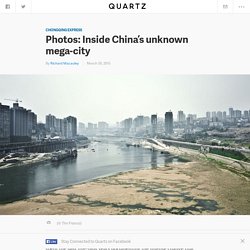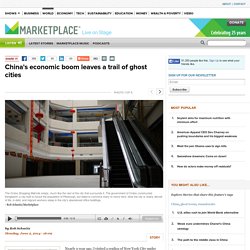

Photos: Inside China’s unknown mega-city. There’s no way around it, the headlines are disturbing.

And they come, not from tabloids or click-bait blogs, but from papers published in scientific journals. They describe fish and birds responding with altered behavior and reproductive systems to antidepressants, diabetes medication, and other psychoactive or hormonally active drugs at concentrations found in the environment. They report on opioids, amphetamines, and other pharmaceuticals found in treated drinking water; antibiotics in groundwater capable of altering naturally occurring bacterial communities; and over-the-counter and prescription drugs found in water leaching from municipal landfills.
And these are just some of many recent studies examining the countless pharmaceuticals that are now being found just about everywhere scientists have looked for them in the environment. Exactly how many drugs are in use and how many may be detectable in the environment is difficult to pinpoint. Where are these compounds coming from? China's economic boom leaves a trail of ghost cities. Nearly a year ago, I visited a replica of New York City under construction outside the Northern Chinese city of Tianjin.

Workers were constructing dozens of skyscrapers on a piece of swampland inside a bend in the river, giving it an uncanny resemblance to the island of Manhattan. There were plans for a Lincoln Center, a Rockefeller center, and much more. Lin Lixue, a salesman for one of the developers, was beside himself. “Our goal is to create the world’s largest financial center, right here, within ten years!” Lin told me. A year later, construction on this city, named Yujiapu, has all but grinded to a halt.
“It was a failure before it even started,” says Gao Fei inside the Tianjin office of Centaline Property, where he works as director of investment consulting. For years, high GDP growth has ensured local officials promotions within the Chinese Communist Party. There’s really nothing else to do here. The Ordos shopping mall next door is five floors of emptiness. China’s Empty Cities and the Law of Supply and Demand. An old friend of my mother had a saying about cooking for guests: "If there isn’t too much food, then there isn’t enough.

" Most mathematically inclined people would agree that the chance of guessing exactly the right amount of food to leave everyone at a dinner party full and happy — that is, on a continuous spectrum ranging from no food to infinite food — is virtually zero. But the analysis of economic growth, and China’s urban planning in particular, has not always heeded this simple insight. On March 16, the Chinese government released a seven-year plan for the continuing urbanization of its population. So far, the process has been an important engine of China’s growth, making workers more productive by giving them better access to capital, services, and economies of scale.
There have been plenty of bumps in the road, though, with huge urban districts built under government orders still waiting for their first inhabitants. This is where the adage about cooking comes in. China's Ghost Cities - 60 Minutes Australia. Empty Cities: China's phony construction boom. China's Ghost Cities. China’s High-Growth Ghost Towns. In the gritty Inner Mongolian wind, I stood at the pinnacle of the global economy, at least in terms of GDP growth: the main drag of one of the fastest growing cities in the fastest-growing region in all of China, the world’s supposed new economic powerhouse.

Built in a breakneck five years, Kangbashi is a state-of-the-art city full of architectural marvels and sculpture gardens. There’s just one thing missing: people. The city, built by the government and funded with coal money, its chief industries energy and carmaking, has been mostly vacant for as long as it has been complete, except for the massive municipal headquarters. It’s a grand canyon of empty monoliths. In a paradox only possible in today’s economic system, Kangbashi manages to be both a boom town and a ghost town at the same time. Kangbashi represents a particularly destructive economic force at work in China today: an obsession with GDP that ignores all other metrics of progress or human capital.